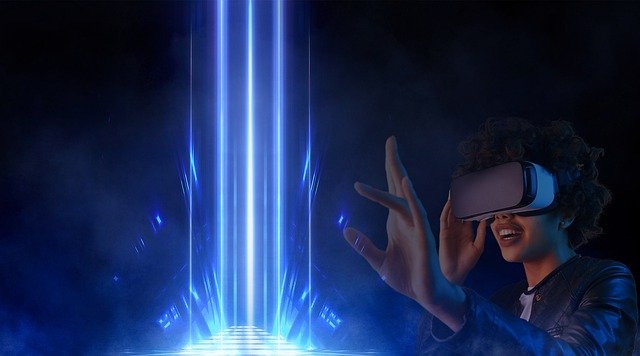Alcoholism: Fast back to life
 |
| Alcoholism: Fast back to life |
 |
| Alcoholism: Fast back to life |
 |
| How to get rid of the of fear |
 |
| Augmented Reality, Virtual Reality - Co. - An overview of immersive technologies |
Over time, a number of terms have been used and defined to classify various forms of virtual technologies. A first taxonomy was made in 1994 by
Milgram and Kishino in the form of the virtuality continuum (Fig. 1). 1 The continuum
represents a scale from the real environment (reality, left) to the virtual environment (virtuality, right)
From left to right along the scale, the proportion of reality decreases continuously and
the proportion of virtuality increases. The further to the right you move in the continuum, the greater it is
corresponding to the proportion of the virtual environment compared to reality. This is synonymous with increasing immersion. Immersion describes the degree of immersion in one
virtual environment. This corresponds to the effect that virtual content or environments are about
different stimuli are perceived as real and the user is part of it
this virtual environment sees. The feeling of presence in the virtual environment is increased
also described with the term presence. Presence is about the entire experience. Depending on the design and implementation of the virtual environment, the content and the characters, the sense of presence can vary in strength. Milgram and Kishino locate the terms augmented reality (AR), augmented virtuality, along the virtual continuum
(AV), Virtual Reality (VR) and Mixed Reality (MR). These terms are presented below according to their Milgram and Kishino definition
VR is on the far right of the continuum. In virtual reality, the visually perceived real environment is completely replaced by a computer-generated virtual world.
There is no visible connection to the real environment. Immersion in Virtual
Reality takes place through the use of special hardware. For a long time, VR was mostly implemented using so-called CAVEs (Cave Automatic Virtual Environment).
The user is surrounded by several large screens on which the virtual
Contents are displayed via stereoscopic projections. With 3D glasses and a corresponding tracking of head movement, the content can be viewed three-dimensionally and in perspective
correctly perceived. Due to technical progress, VR is now mostly implemented over head-mounted displays (HMD). There
each eye is shown an individual, slightly offset image through its own display,
a three-dimensional perception can be generated. By using such a
HMD, the user is completely immersed in the virtual world and has non
Relation more to the real environment. The immersion in an artificially created world does mentally noticeable on three levels: the spatial perception, the perception of theEnvironment and attention or involvement in the simulated world. Realistic acting and interacting can be carried out in the same way as in real life via various user interfaces Environment
According to the continuum, AR is a combination of real and
virtual world in which the real world predominates. In contrast to VR, AR does not create a new world,
but extends and improves the existing real environment. AR becomes reality
supplemented accordingly with digital content. One also speaks of "augmented reality". Through
the use of mobile devices such as smartphones or tablets, but also of
corresponding AR glasses, additional information is displayed over the real world.
Additional information can include 2D elements (text, image, video) and audio formats or
also be interactive three-dimensional models and animations. This enables a look through
For example, a cell phone camera combines reality and virtuality in real time.
Interaction with the virtual content can also take place in AR through various user interfaces;
Augmented virtuality mixes reality and virtuality. However, that predominates
Share of virtuality. AV can be viewed as a form of virtual reality in which parts
the real environment and visualized in the virtual world. So can
For example, the user's hands can be visually integrated in real time
enable intuitive interaction. Depending on the application, individual real
Objects or other people are involved. The term augmented virtuality is not very widespread and is rarely used,
Extended Reality (XR)
The continuum of virtuality is the consensus, especially in science. When Milgram and Kishino worked out the taxonomy, however, it was not foreseeable how the technologies would develop further and what new possibilities would arise. Meanwhile are
therefore further terms have been defined and the meaning of existing terms has been modified.
A relatively new term that is gaining ground in both industry and research
Established is Extended Reality (XR). XR can be used as an umbrella term for all virtual technologies
use. The term itself is not uniformly defined and is still so new that it is currently used
Duden cannot be found. Basically, the X can be viewed as the unknown and through
replace any matching variable.2 Thus, XR includes both AR, AV, VR and also MR after
the definition of Milgram and Kishino.
In addition, the term Assisted Reality (AS) is due to the development of so-called Smart Glasses
like the Google Glass. Google Glass and similar glasses have one small screen that presents the user with an image directly in their field of vision. Since only one eye can see this image, there is no three-dimensional perception. in the unlike AR, the information on the screen is not superimposed on or combined with the physical environment. Assisted Reality is accordingly very low
Degree of immersion. The user, however, gets information visualized in a needs-based and context-specific way and can use both without restrictions hands work. Assisted Reality is therefore, as the name suggests, very suitable for assistance systems of all kinds,
Another term in the context of immersive technologies is spatial computing (SC). The term was launched in 2003 by Simon Greenwold as part of his master's thesis. 3 It is now often used as a synonym for XR. In contrast to XR, SC is original but less of a term used to classify technologies and more an approach to description of the change in human-machine interaction. Instead of 2D screens and To be bound to classic user interfaces, spatial computing exploits three-dimensional physical space. For previous physical interfaces between humans and computers were essentially developed from the keyboard and the computer mouse. With the however, today's technical possibilities are also more of a natural means of communication between man and machine possible based on the fundamentally intuitive human interactions such as language and gestures are based. This form is also used in spatial computing , preferably used. Conversely, from machine to person, information is released presented in the room and you can work with them. In addition, machines can perceive, store and (virtually) manipulate real spaces. Thanks to the latest Internet of Things and communication solutions, a large number of devices and machines of the most varied types can be networked with one another. In this way, for example, the user interfaces can also be implemented in terms of hardware separately from the actual data processing, such as cloud computing or remote rendering.
 |
| Bitcoin and cryptocurrencies what happens now |
 |
| Here is 4 plans you should write for the new year 2022 |
Year after year - for many people that also applies to the calendar. We chat, stream, zoom and nimble. We synchronize shopping lists with loved ones, measure the pulse digitally and count steps. Read e-papers and shop online. We also send each other entries for the digital calendar. A real calendar, with pages made of paper and hard cover, continues to accompany many people. And they buy a new one every year, register birthdays, draw up to-do lists, and note down instructions from the boss.
It is questionable whether the person is really relieved with the offers of all the online service providers that are supposed to make life easier. The ever-growing calendar business points in a different direction. There are the annual planners, mindfulness planners, travel planners, financial planners, exam planners, fertility treatment planners, wedding planners, planners for groomsmen and backward-looking planners. Some planning concepts are so complex that the organizational stuff probably takes more time than the implementation.
The first invitations for the new year have arrived and the question arises as to how much planning is needed for 2022. Psychologist Denise Ginzburg advises: With every planning there should always be enough room for the unplanned.
Denise Ginzburg, a psychologist, has already planned her 2022 pretty well. She starts planning the new year in the summer of the previous year. She asks friends and relatives whether there are any festivities coming up in the New Year and talks to her family about vacation planning. It is always important to her to keep the balance between the planned and the unplanned.
She therefore advises actively blocking time for spontaneous things so that these days or hours are not accidentally rescheduled for other appointments. Your first step is always to plan the vacations to build everything else around it. She also blocks long bridging days or just afternoons when she deliberately has no plans.
But how do you find out which system is the right one for you? Often it also helps here to simply listen to your gut instinct. Extroverts may spend less time with themselves and draw a lot more energy from meeting other people. Other people refuel better when they can really relax and just do nothing. But you can plan both.
For Denise Ginzburg, an appointment calendar is the be-all and end-all. With calendars that run from week to week, however, she sees the danger that they often lead to losing sight of the big picture. That is why she advises purchasing an annual planner at the same time.
Your vision is what your business is all about.
What you do things for.
Take the time to clarify your vision, to continue to build a business in your image.
I invite you to write this vision down, come back to it over several days, and dig into it (through writing in particular).
In addition to working on my vision, I like to give intention to my year ahead.
An intention is an aspiration that sticks to your vision.
It can be symbolized by a wor
 |
| The blockchain revolution fields of application, definition, and operation |
 |
| The Future of the Internet: METAVERSE |